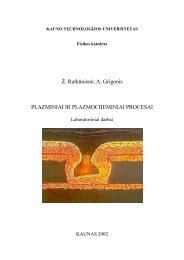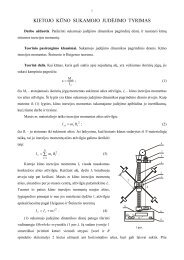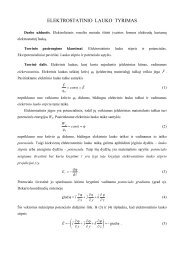PROCEEDINGS OF THE 7 INTERNATIONAL ... - Fizika
PROCEEDINGS OF THE 7 INTERNATIONAL ... - Fizika
PROCEEDINGS OF THE 7 INTERNATIONAL ... - Fizika
You also want an ePaper? Increase the reach of your titles
YUMPU automatically turns print PDFs into web optimized ePapers that Google loves.
S. Mockevičienė et al. / Medical Physics in the Baltic States 7 (2009) 121 - 122<br />
Table1 Main characteristics of investigated porous silicone structures<br />
Samples HF: HNO3 Etching time, h Porous layer thickness, μm Refractive<br />
index<br />
Porosity, %<br />
N8 1:1 24 4.201 1.21 83.6<br />
N10 1:2 24 2.767 1.32 75.3<br />
N11 1:6 24 2.103 1.50 61.4<br />
N5 4:1 24 2.013 1.43 66.8<br />
N20 4:1 48 3.934 1.21 83.6<br />
N4 4:1 60 4.851 1.17 86.7<br />
a) b) c)<br />
Typical for porous silicon Si-H, Si-O-Si, SiH2 peaks<br />
were found in the initial FTIR spectra of different<br />
samples.<br />
Increase of HNO3 concentration in the acids mixture<br />
resulted in the creation of additional Si-Hx groups seen<br />
in FTIR spectrum (Fig.2). Created Si-Hx groups were<br />
responsible for the number of new formations (pores) on<br />
the sample surface.<br />
Fig.2. FTIR spectra of a sample No11 before (A) and<br />
after (B) its irradiation with X-ray photons.<br />
Spectral intensity was lower for the whole energy range<br />
after the irradiation of samples with high energy X-ray<br />
photons. In the case of the highest HNO3 concentration<br />
used for the fabrication of samples (Sample No11) it<br />
was clearly seen, that the intensity of Si-Hx bonds was<br />
lower and some bonds disappeared, thus reducing<br />
limiting property of the structure for the grow of pores<br />
into the depth, Such a behaviour most likely is related to<br />
122<br />
the release of hydrogen during the exposure of samples<br />
to X-ray photons.<br />
4. Conclusions<br />
Surface morphology and porosity of porous silicon<br />
depend on the technological parameters of vapor phase<br />
etching. Increasing concentration of HNO3 in the<br />
mixture, leads to the creation of the new formations on<br />
the sample surface and limits pore growth into the<br />
depth. Radiation induced changes of properties are not<br />
significant. However, they are related to the surface<br />
reconstruction due to the hydrogen release during<br />
irradiation. Modification of porous silicon surface using<br />
high energy photon beams is possible only in the case,<br />
when HNO3concentration in the acids mixture is<br />
relatively high.<br />
5. References<br />
1. Z. Chuan Feng, R. Tsu. Porous silicon, World<br />
Scientific, 1994, P. 465<br />
2. A.P. Hakhoyan, S.V. Melkonyan Features of the<br />
refractive index of porous silicon with gradient porosity.<br />
Armenian Journal of Physics, vol. 1, 2008, pp. 146-150;<br />
3. R Herino, G Bomchil, K Barla and C Bertrand,<br />
Porosity and pore size distribution of porous silicon<br />
layers, J Electrochem Soc, Vol 134, No 8, pp 1994 -<br />
2000 (1987).<br />
4. H. Kaabi, N. Mliki, M. Cheynet, W. Saikaly, O.<br />
Gilbert, B. Bessaïs, B. Yangui , Structural and optical<br />
properties of vapour-etching based porous silicon, 2006<br />
WILEY-VCH Verlag GmbH & Co. KGaA, Weinheim,<br />
P 155-157.








